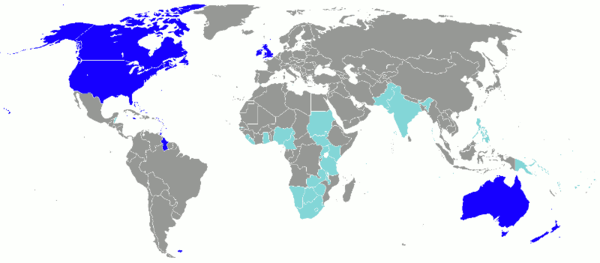Caribbean English
This article includes a list of general references, but it remains largely unverified because it lacks sufficient corresponding inline citations. (August 2009) |
| Part of a series on the |
| English language |
|---|
| Topics |
| Advanced topics |
| Phonology |
| Dialects |
|
| Teaching |
Higher category: Language |
Caribbean English dialects of the English language are spoken in the Caribbean and Liberia, most countries on the Caribbean coast of Central America, and Guyana and Suriname on the coast of South America. Caribbean English is influenced by but is different from the English-based Creole varieties spoken in the region. In the Caribbean, there is a great deal of variation in how English is spoken. Scholars generally agree that although the dialects themselves vary significantly in each country, they primarily have roots in British English and West African languages. Caribbean English in countries with a plurality Indian population, such as Trinidad and Tobago and Guyana, has been influenced by Hindustani and other South Asian languages, in addition to British English and West African languages.[1][2][3]
Overview[]
- The daily-used English in the Caribbean has a different set of pronouns, typically me, meh or mi, you, yuh, he, she, it, we, wi or alawe, wunna or unu, and dem or day. I, mi, my, he, she, ih, it, we, wi or alawe, allayu or unu, and dem, den, deh for "them" with Central Americans.
- Consonant changes occur like h-dropping or th-stopping are common.
- Some might be "sing-songish"[clarification needed] in Trinidad and the Bahamas.
- Rhotic: Bajan (Barbadian), Guyanese
- Influenced by Irish English: Jamaican, Bajan
- Influenced by African American Vernacular English: Liberian or Liberian English
- Influenced by any of the above, as well as Spanish and indigenous languages: Central American English dialects like the Belizean Creole (Kriol), or the Mískito Coastal Creole and Rama Cay Creole spoken in Nicaragua
However, the English used in media, education and business and in formal or semiformal discourse approaches the internationally understood variety of Standard English (British English] in all former and present British territories and American English in Puerto Rico and the U.S. Virgin Islands) but with an Afro-Caribbean cadence (Spanish cadence in Puerto Rico and the Archipelago of San Andrés, Providencia and Santa Catalina).
Samples[]
Standard English: Where is that boy? /hwɛər ɪz ðæt bɔɪ/
- Barbados: 'Wherr dah boi?' ([hwer ɪz dæt bɔɪ]) (spoken very quickly, rhotic with glottal stops)
- San Andrés and Providencia: 'Weh dah boi deh?' ([hwe dæt bɔɪ deh])
- Jamaica: 'Weh dah bwoy deh?' ([weh da bwoj de]) (sporadic rhoticity from Irish and Scottish influence); or 'Wey iz dat boi?' [weɪ ɪz dæt bɔɪ] (non-rhotic and similar to the accents of southwestern England and Wales)
- Belize: 'Weh iz dat bwoy deh?' ( [weh ɪz dɑt bɔɪ deɪ]) (British and North American influence but deeper in tone)
- Trinidad: 'Wey dat boy deh?'
- Bahamas: 'Wey dat boy iz?' [Some would more likely say bey, instead of boy]
- Guyana and Tobago: 'Weyr iz daht boy/bai?' (urban) or 'Wey dat boy dey?' (rural) ([weɪɹ ɪz dɑt baɪ]) (many variations depending on urban/rural location, Afro or Indo descent or area, and competency in standard English; sporadic rhoticity)
- Saint Vincent and the Grenadines: 'Wey dah boy deh deh?' ([weɪ dɑ bɔɪ deɪ deɪ]) (non-rhotic)
- Belize, Nicaragua, the Bay Islands, Limón, Puerto Rico, and the Virgin Islands: 'Wehr iz daht booy?' ([weɹ ɪz dɑt buɪ]) (distinct, sporadic rhoticity, pronunciation becomes quite different from Creole pronunciation)
- Dominica: 'Weh dat boy nuh?'/'Weh dat boy be nuh?' (spoken harshly and with a deep tone)
The written form of the English language in the former and current British-controlled Caribbean countries conforms to the spelling and the grammar styles of Britain and in Puerto Rico and U.S. Virgin Islands conforms to the spelling and the grammar styles of United States.
See also[]
- Anguillan Creole
- Bajan Creole
- Bajan English
- Bahamian Creole
- Belizean Creole
- Bermudian English
- Cayman Islands English
- English-based creole languages
- Grenadian Creole English
- Guyanese Creole
- Jamaican English
- Jamaican Patois
- Liberian English
- Montserrat Creole
- Nicaragua Creole English
- Puerto Rican English
- Regional accents of English speakers
- Saint Kitts Creole
- Samaná English
- San Andrés-Providencia Creole
- Sranan Tongo
- Tobagonian Creole
- Turks and Caicos Creole
- Trinidadian Creole
- Trinidadian and Tobagonian English
- Vincentian Creole
- Virgin Islands Creole
- Gullah Language
References[]
- ^ Mahabir, Kumar (1999). "The Impact of Hindi on Trinidad English". Caribbean Quarterly. Trinidad and Tobago: Taylor & Francis, Ltd. 45 (4): 13–34. doi:10.1080/00086495.1999.11671866. JSTOR 40654099.
- ^ Holbrook, David J.; Holbrook, Holly A. (2001). Guyanese Creole Survey Report (PDF) (Report). SIL International. Archived from the original (PDF) on 9 July 2018. Retrieved 23 July 2018.
- ^ "The Languages spoken in Guyana".
- Freed, Kenneth (May 11, 1993). "Caribbeanspeak: The area's languages range from Creole to Patois, from English to French. And therein lies a growing dispute involving power and equality". Los Angeles Times. Archived from the original on 1 April 2019. Retrieved 2009-08-22.
- Aceto, Michael (2004). "Eastern Caribbean English-derived language varieties: morphology and syntax". In Schneider, Edgar Werner; Kortmann, Bernd (eds.). A Handbook of Varieties of English: A Multimedia Reference Tool. 2. p. 439. ISBN 978-3-11-017532-5.
External links[]
- Linguistic map of Caribbean English dialects from Muturzikin.com
- Caribbean English (British Library)
- Cross-Referencing West Indian Dictionary
- Bajan (Barbadian) dialect in NYC at the Wayback Machine (archived July 9, 2011)
- Dialects of English
- Languages of the Caribbean
- North American English
- Languages of Liberia
- Languages of Trinidad and Tobago
